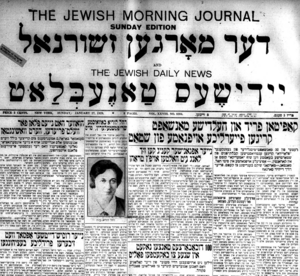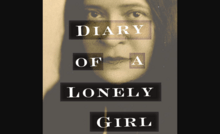Rachel Luria
Front page of Yiddish newspaper The Jewish Morning Journal, with photograph of Yiddish author Rachel Luria, January 27, 1929. From the National Library of Israel.
Rachel Luria (Rokhl Lurye) was born in Kovno (now Lituania) in 1886 but immigrated in 1897 to the United States. She published her first Yiddish story in 1909 and by 1915, was a regular contributor to the Yiddish paper Varheyt. She went on to write many short stories, noted for their complex portrayals of gender and immigrant life, including “The Powdered Corpse,” “The Butterfly,” and “The Illusion.” She was also a stunt journalist, an investigative journalist whose gender made her adventurousness sensational. She continued to write fiction and nonfiction until she died in 1929 and was one of the founders of the American branch of YIVO and an early member of the Y.L. Perets Writers’ Association.
Early Life and Family
Rachel Luria (Rokhl Lurye) was born in Vorzshon (Veiviržėnai), in the region of Kovno (now Kaunas, Lithuania) in 1886. Her father was a merchant descended from the Luria family of Zhager (Žagarė) and her mother was a cousin of the prolific newspaperman Getsl Zelikovich. Luria received a traditional Jewish education both at home and in cheder. She also learned to read German early in her childhood.
Luria immigrated to New York in 1897 at the age of eleven. She began to work in a sweatshop and studied in the evenings, first alone and later in night school and a commercial school. She also worked as a nurse in a hospital. Her writing first appeared in 1909 in the anarchist Yiddish newspaper Fraye arbiter shtime, which was known for publishing a wide range of radical Yiddish writers and holding a high literary standard.
Luria was married to Yiddish writer Z. Broches. Her brother, Benjamin Wolf, was a painter whose work depicted his world travels.
Writing Career
Sometimes writing under the pseudonym Paula Nor, Rachel Luria wrote short fiction, humoresques, and feuilletons for a wide array of Yiddish newspapers during a time when the Yiddish press was flourishing as the primary vehicle for mass culture for the Yiddish readership. She wrote for left-leaning newspapers that offered literature, art, criticism, and culture in addition to news or political coverage. Her writing appeared in Dos naye land, Glaykhkyt, Fraye arbiter shtime, Folksadvokat, Dos naye lebn, Di Idishe shtime, Dos idishe folk, Kinder zhurnal, and Minikes yontev bleter. In 1915 she became a regular contributor to Varheyt; in 1917 she wrote regularly for Tog; in 1920 for Di tsayt. She later joined Morgn-zhurnal as a staff writer. A few of her stories were translated into Hebrew during her lifetime.
Luria wrote psychologically complex, sometimes grotesque, stories about immigrant life, often with a cynical vantage point on relations between men and women, sexual politics and desires. In her story “The Powdered Corpse,” when a Jewish immigrant in New York dies on erev Shabes, the secularizing immigrants are paralyzed with the question of how to care for the body—whether or not to wait until after Shabes while the body decays in the summer heat. Ultimately the immigrant is buried in a coffin wearing make-up, according to the customs of a Christian undertaker, a decision that is made without the permission of her mourning family members. Death, and the economics and logistics of burial, have created an opportunity for her to be forcibly assimilated posthumously. Her assimilation in death renders her face unfamiliar and unseemly to her family, her body manifesting a sexual politics of immodesty at odds not only with her community but also with her own life.
In Luria’s story “The Butterfly,” a couple admiring ships on the ocean become enamored with a butterfly that the husband catches and his wife brings home. As the wife holds the butterfly with its wings spread open, the man begins to think about its body, and how ashamed it must be to be so exposed. While the husband wants to set the butterfly free, the wife and her sister want to pin it so it can be displayed as a dead specimen. The conflict offers the husband an opportunity to reflect on how he, himself, is no longer free but rather pinned to his marriage and opens up reflections on innocence, deceit, and death.
In addition to her fiction, Luria was also a stunt journalist, an investigative journalist whose gender rendered her adventurousness sensational. In 1923 she visited Lilian S. Raizen in jail on the eve of her famous murder trial (Raizen had made headlines for killing the family physician, Abraham Glickstein, and unsuccessfully made a plea of insanity), and Luria shared their conversation, as well as reportage from the trial itself, with readers of the Morgn zhurnal.
In 1925 Luria traveled to Palestine, where she stayed for over a year. An evening in honor of her departure from the United States included literary readings by well-known figures such as Shmuel Charney, Leon Kobrin, Avrom Reyzin, Kalmen Marmor, and Dovid Pinski. She described her travels in a series of sketches published in Morgn zhurnal.
In addition to her writing, Luria also gave English lessons in a café on East Broadway, for which she advertised in the Yiddish press. Her name is often associated with that of her contemporary, Yiddish short story author and novelist Miriam Karpilove, as well as popular novelist Sarah B. Smith, short story author Fradl Shtok, and actress Fania Marinoff.
In 1918, Luria published a collection of stories in book form under the title Modne mentshn (Strange People), which was praised by critics for its originality and for sympathetically portraying a wide range of downtrodden characters. She also published Zibn vayber in eynem (Seven Wives Altogether) in 1925.
Luria was among the first members of the Y.L. Perets Writers’ Association and among the founders of the American Division of YIVO.
Rachel Luria died on January 28, 1929, at the age of 47, after an extended illness. She is buried in Mt Carmel Cemetery, Long Island, in the Worker’s Circle cemetery.
Selected Works by Rachel Luria
Modne mentshn (Strange People). New York: Nay tsayt, 1918.
Zibn vayber in eynem (Seven Wives Altogether) (New York, 1925).
In English Translation:
“The Butterfly,” trans. Rachel Mines. Jewishfiction.net, 2023.
“Herring,” trans. Aaron Lansky and Leonard Glick. Pakn Treger no 3, winter 1984. Reprinted in The Abandoned Book and Other Stories, edited by Eitan Kensky. Amherst, MA: White Goat Press, 2019, pp. 15-19.
“The Illusion,” trans. Jessica Kirzane. Jewishfiction.net, 2021.
“The Powdered Corpse,” trans. Jonah Lubin. Pakn Treger Digital Translation Issue, 2022.
“Strange People,” trans. Dan Setzer. http://www.dansetzer.us/luria/
Dingol, S. Review of Modne Menshen. Yidishes Togeblat. April 27, 1919, p. 6.
Glantz, A. “Oyfn grenits tsvishen emes un ligen.” Review of Modne Menshen. Der Tog, March 30, 1919, p. 9.
“Rachel Luria.” Obituary. Davar. January 29, 1929, p. 1.
“Raykher program bay dem ovnt far Rokhl Lurye.” Der Tog, May 22, 1925, p. 3.
“Rokhl Lurye, bavuste shriftshtelerin, toyt.” Obituary. Morgn zhurnal. January 27, 1929, p. 1.
“Rokhl Lurye.” In Zalman Reyzen, Leksikon fun der Yidisher literatur, prese, un filologye, Vol. 2. (Vilna, 1927), pp. 107-108.




